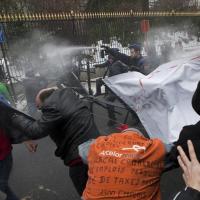
Struggle at Arcelor Mittal Liège against redundancies
Since Arcelor Mittal announced yet another social bloodbath at an extraordinary works’ council on 24 January, the future of steel production in Liège has been at the centre of Belgian public attention. On the following morning, a high profile meeting was organised in Brussels, involving both the federal and the Walloon regional governments. Then, early that Friday afternoon they received the union representatives. They did not come alone, but were accompanied by up to 500 angry and combative workers, which in reality meant an assembly in front of the prime minister’s residence. A delegation from the Left Socialist Party (LSP/PSL, the CWI in Belgium) was also present in solidarity.
This announcement was not really a surprise. Only 15 months ago, September 2011, Mittal decided to close its blast furnaces, with a loss of 795 jobs. The unions demanded nationalisation, but the regional Walloon government replied that this was impossible and would not be accepted by the European Union. The unions pointed to the fact that the federal government had nationalised Dexia, one of Belgium’s biggest banks, only weeks before, adding that an investment of 1 billion euro would be sufficient to modernise the sites, only a quarter of the amount the government had mobilised in a few days’ time for the takeover of Dexia.
Then Mittal promised to invest in its cold, finished steel, production phase, which the Walloon government decided to subsidise. Even some trade union leaders relied on Mittal’s’ good intentions to safeguard some activity in Liège. This explains why, after some initial successful demonstrations in Liège of 10,000 workers in October and 40,000 workers in December 2011, mobilisations stopped. Since then, management and trade unions still have not reached an acceptable agreement concerning the closure of the hot production phase.
At that time, the employees’ union had on its banner “Slaves who accept everything will not be spared by the tyrants.” With the closure of the blast furnaces, the danger of a progressive dismembering leading to a total closure was imminent. That’s why the unions originally demanded nationalisation of the integrated steel industry of Liège. Since Mittal’s 24 January announcement of the closure of 7 of the 12 units of finished steel and coke production at the cost of another 1,300 jobs, the PSL’s perspective that “with the threatening closure of the hot phase, it’s only a question of time before the cold phase will be hit”, has unfortunately been confirmed.
Workers are well aware of this. They have had enough of the management’s and politicians’ promises. Immediately after the announcement, they went on an all-out strike, at least until the general assembly planned for Monday, January 28. Anger is deep seated. This was reflected in front of the prime minister’s residence on Friday. Immediately after being dropped off by busses, workers headed for wired steel barricades erected by the police and a fight lasting for hours broke out, with the police using tear-gas and water cannon.
Another idea that was put forward by PSL, to discuss an action plan with the aim of nationalisation under workers’ control and management, is now resurging. When the trade union representatives coming out of the meeting on Friday explained the government “was with” the workers and looking for a buyer, the protesting workers chanted “expropriation and nationalisation”. After months of lies, why rely on those who are inflicting austerity on us, who are removing staff positions in public services while promising their support and solidarity to save our jobs? It’s time for workers to organise independently, to meet and discuss their own alternative and an action plan to impose it.
The question of a new private buyer will not remove the loss of jobs. It is sure that the new owner will come up with conditions to further reduce production costs. It is crucial workers keep control of the equipment and tools to avoid decisions being taken over their heads. An action plan can lay the foundations for an occupation, the election of a committee to coordinate the struggle, to mobilise support in the population and to keep the machinery intact. An action plan should also look beyond the steel industry or the region of Liège alone, and look to link up with the workers of Ford in Genk also being confronted with closure, plus the railway workers and the federal public sector workers who are all planning struggles out in the coming weeks.

The confrontation with the police has illustrated two things: the first measures of the government to support the workers are tear-gas and water cannon. Secondly, the combativeness of the workers who are not prepared to pull back and stand by. An action plan is the necessary tool to channel this combativeness and to orientate it towards victory for the workers’ demands.

Be the first to comment